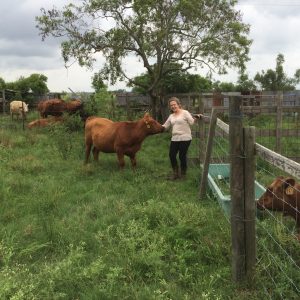#3 of a series about life at the EO Ranch by Barb Harr
So, as I was saying, keeping the “easy keepers” is the goal!
To us, that means cows that get busy and graze without being too picky, calve every year, provide enough milk to give their calves a great start, and are just docile enough that they work with us (not against us).
As stated in my last post, “We just gotta be careful that we don’t . . . . . let our cows put the squeeze on us.” Disposition is one of those traits that we could easily carry too far, ending up with a lot of ‘nice’ cows that may like our attention but don’t perform well. We have some that are so ‘nice’ that at times it seems they would rather hang with us than do the ‘herd thing!’

But as things turned out, having ‘nice’ cows was the only thing we COULD think about on the day we made our first cull! Here’s that story…
. . . Our herd started with the purchase of 14 local crossbred heifers that we intended to move from their native pasture to our leased acreage about 30 minutes away. Only 13 of them got moved as “the SANITY trait” compelled us to send one to the local sale barn right then and there.
As we began to pen our new little herd to make the move, we quickly found we had acquired a heifer that must have spent a former life posing for cartoonists. She looked the part of the classic comic strip bull – curly hair on the top of her head, flaring nostrils, big round belly, and hooves stomping and pawing the ground as she took stock of us.

image credit: dreamstime
Well, we took stock of her body language and quickly exited the pen to regroup – and she quickly exited the herd!!!
Apart from that incident early on, it has proven really hard for us to cull (fancy way of saying “send to the sale barn and get less than what you’re sure a cow is worth”) while we have been trying to build our herd.
The 13 from our original 14 are still around! As we take notes and observe, we have identified two or three of them that will eventually be removed from the herd. We’ve been threatening for a while, especially when we have felt threatened ourselves, but beginning the process is a process in itself! Even our neighbors, who have been cow people for years, lament that culling is something that is hard to do – you always want to give that cow ‘One More Chance!’ Since we hope to be in this for the long haul, we will be needing to make some “Cull Calls” soon. In the meantime, we’re moo-ving along, watching carefully and learning as much as possible about cow behavior, genetics, perfomance on grass, etc. Hopefully, we will get good at choosing “easy keepers” as we forge ahead.
By the way, speaking of choosing (unless you’re going to go the AI route – which we’re not), no herd can be built on just a bunch of females!
We had to choose a BULL for our 13 girls…
Now that’s another story…








